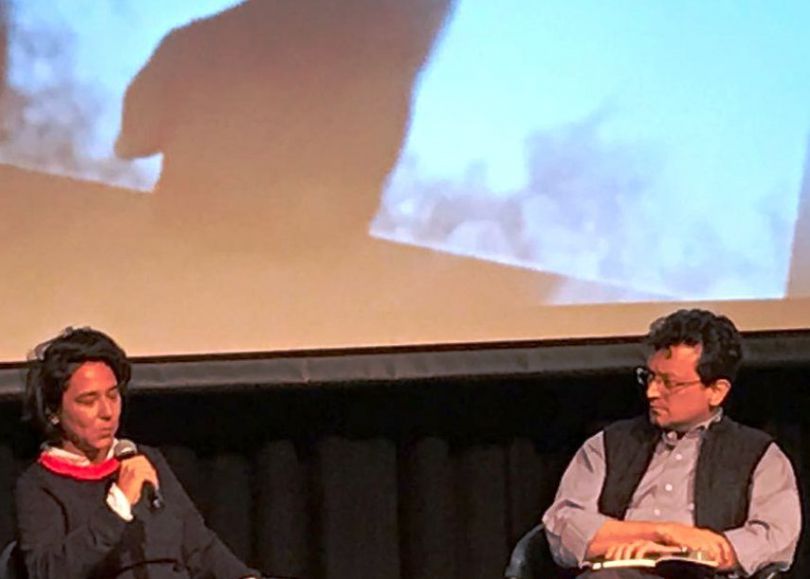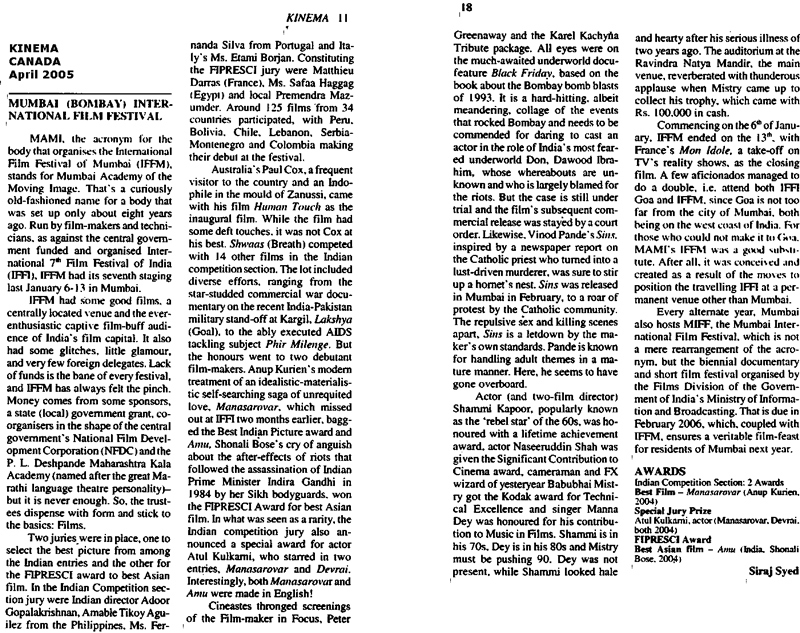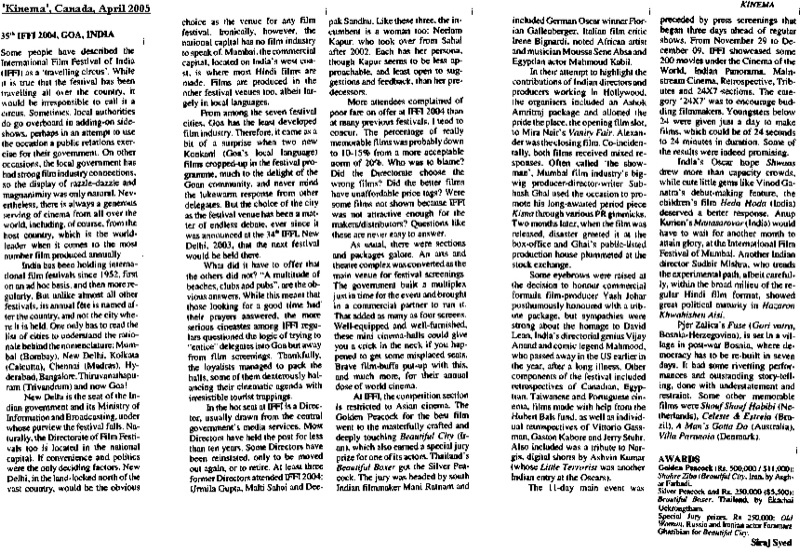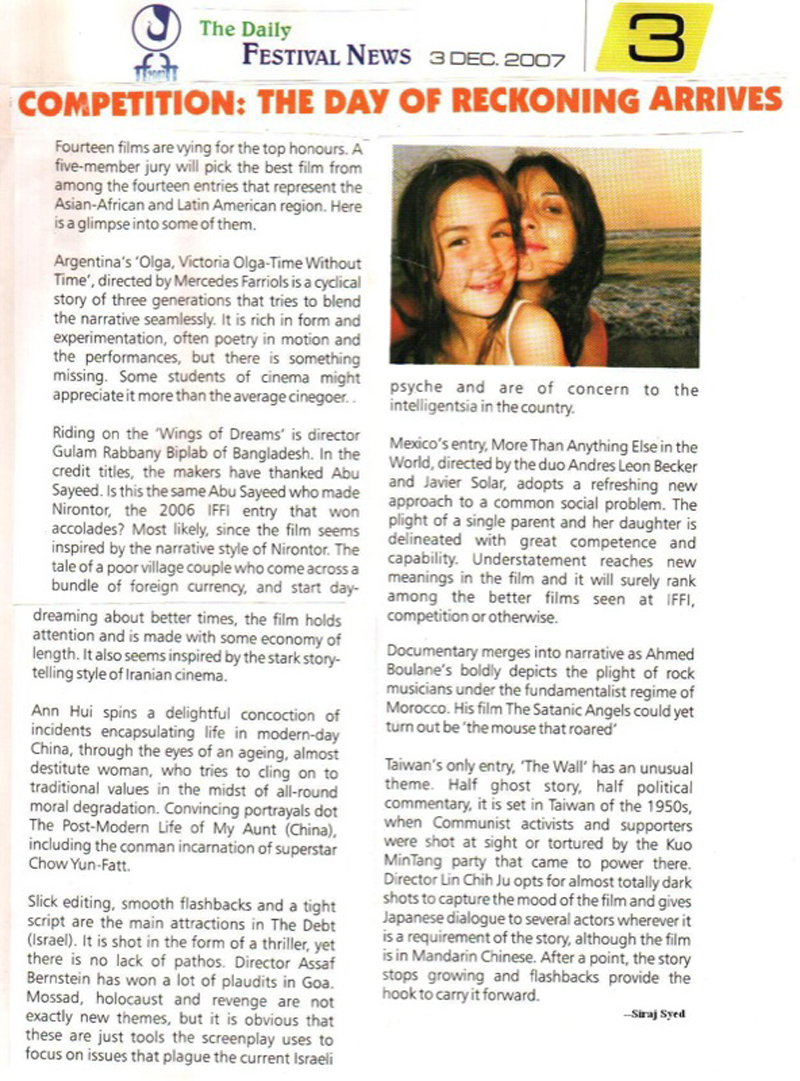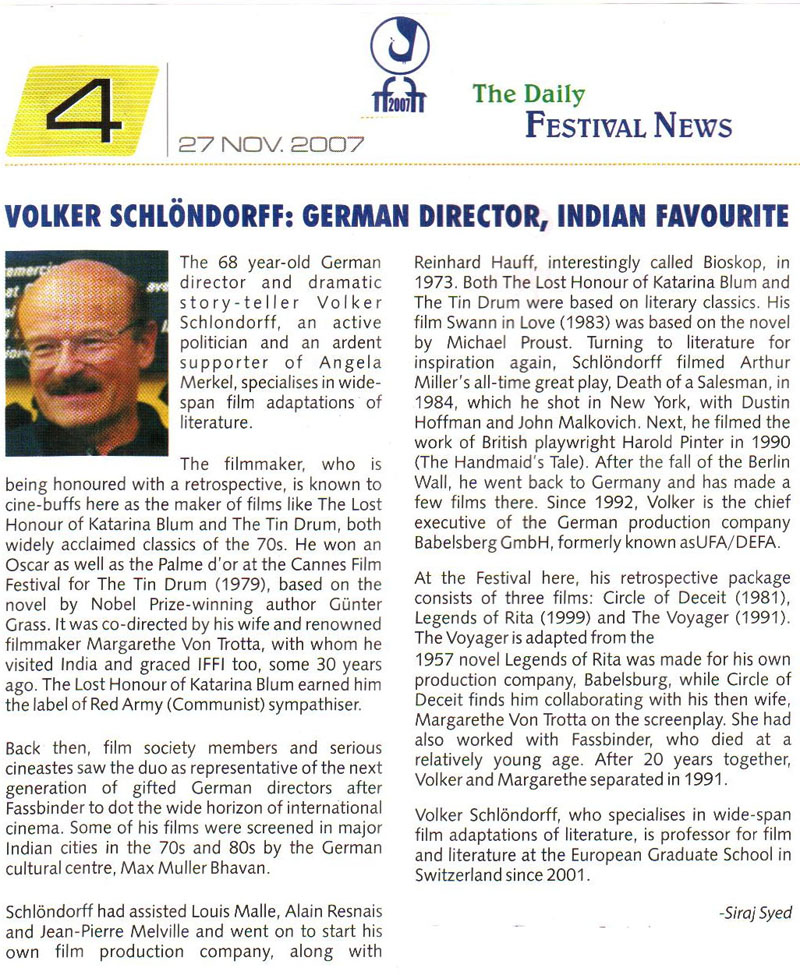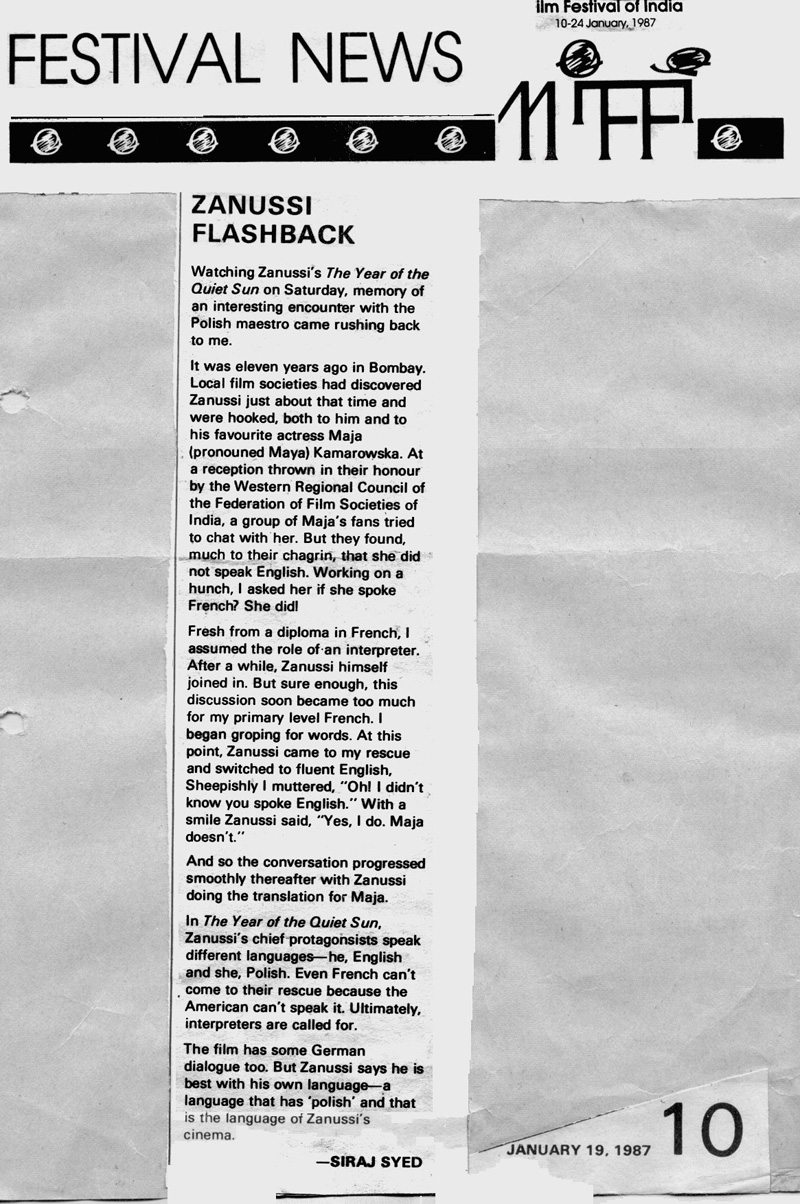|
|
||
|
Pro Tools
FILMFESTIVALS | 24/7 world wide coverageWelcome ! Enjoy the best of both worlds: Film & Festival News, exploring the best of the film festivals community. Launched in 1995, relentlessly connecting films to festivals, documenting and promoting festivals worldwide. We are sorry for this ongoing disruption. We are working on it. Please Do Not Publish until this message disappears. For collaboration, editorial contributions, or publicity, please send us an email here. User login |
Siraj SyedSiraj Syed is the India Correspondent for FilmFestivals.com and a member of FIPRESCI, the International Federation of Film Critics. He is a Film Festival Correspondent since 1976, Film-critic since 1969 and a Feature-writer since 1970. He is also an acting and dialogue coach. @SirajHSyed  Siraj Syed reviews ‘A Million Rivers’: Complex hOMage to simple man PURI
Siraj Syed reviews ‘A Million Rivers’: Complex hOMage to simple man PURI This ‘homage’ began as a ‘tribute’ to Om Puri, counterpoised against Lillete Dubey, by writer-director Sarah Singh, four years before his death, in 2013, and was completed in 2016. We saw the film on 30th January 2017, at the Black Box, in Central Mumbai, courtesy the G5A Foundation for Contemporary Arts and Culture. When I last met Om Puri in the last week of November 2016, at the International Film Festival of India, Goa, Panjim, he was not in the mood to talk about cinema. After a warm hug, that went back 40 years, he said, “I’m here to meet Bobby, and eat the wonderful food that he serves at his catering franchise, not to attend IFFI itself. You try it out, too.” I couldn’t, and the next piece of news about Om came a month later, when I was in Mumbai. He was dead. A mere 364 days older than me, and a man who was modesty personified, his departure left me in state of strange numbness. I hadn’t seen any of his films for a few months, and there were none lined up. The loss hadn’t even really sunk in, till I got this email from G5A. And I joined the million rivers who were crying their hearts out, led by Chef Mourner, Sudhir Mishra. G5A was screening his unreleased 52 minute B&W vehicle, A Million Rivers, made by Sarah Singh, an NRI who lives in America. Sudhir just could not stop the eulogy and anecdotes, from Jaane Bhi Do Yaaro (which Sudhir co-wrote) and Dharavi (where director Sudhir cast him as the protagonist). You could see he was deeply moved and didn’t want to stop admiring the qualities and the abilities of the late friend he had recently lost. In a small way, I was part of those memories too, especially the Bandra days of the late 70s/early 80s.
Whether A Million Rivers is really a tribute to the cinematic genius Om Puri or not is a tough question. He is captured in the most brilliantly lit environs, his frame and visage acting out a million stories silently, with props like cigarettes, flowers and guns, while uttering only one sentence in the film, that, far from profound, and, in fact, humorous. Whether A Million Years is a film at all is another question we have to mull over. Inspired by Brechtian (original name Eugen Berthold Friedrich Brecht,1898-1956, German poet, playwright, and theatrical reformer, whose epic theatre departed from the conventions of theatrical illusion and developed the drama as a social and ideological forum for leftist causes; a favourite among leftist theatre groups in India too, like IPTA) distancing techniques, works of Eurpoean masters, Warhol and Mani Kaul (Uski Roti?), Sarah has used locations, cameras (many of them), ambient sounds, music, and dialogue as very rarely seen on the international screen, let alone India.
At the Q&A after the show, moderated by veteran poet, journalist, art and literature personality, Ranjit Hoskote (who kept trying to “draw you into”), a member of the audience likened her fragmentary cutting style to that of the bête noire of India’s (government-run documentary producing unit) Films Division, Pramod Pati, but Sarah denied having seen any of his work. Jean Luc-Godard (French-Swiss, now 86), Miklos Jancso (died 2014, aged 93) and some other Hungarian auteurs of the 60s and 70s came to my mind, and I couldn’t help asking her, “Sleep (a 1963 American film by Andy Warhol (American pop art icon, died 1987) consisting of long take footage of John Giorno, his close friend at the time, sleeping, for five hours and 20 minutes)?” She, instead, named another, another Warhol favourite, The Screen Tests (1964-66), as a major influencer. A Million Rivers is a surrealist, semi (make that quarter)-narrative fiction film, set in South Asia (read Kashmir and the divided Punjab province, West with Pakistan, East with India). Themes of fragmentation and fantasy are explored in this black and white, chapter-divided: a man with a mirror reflects all that is around him, never turning the mirror to reveal himself, being a centre-piece. Elements to ponder over, before and during the viewing of the film. 1. Sarah Singh made the film with almost no budget. --Congratulations 2. She said she knew what she wanted, in her mind, but was sometimes unable to convey it to Om Puri and Lillette Dubey. –They, in turn, have been unable to explain to us, audiences. 3. There is almost no dialogue, because there is a real-life breakdown in communication, alluding to the Kashmir issue and the divided families. --That does not mean that the four lines that are spoken are the raison d’être of the film. The lines themselves range from mundane to contextual. 4. Sound track is jarring, levels fluctuate dramatically, and the music plays with you.—That means it is deliberate, and the more you find it jarring, the more you are with the film. 5. Images are often out of focus or frames awkwardly construed.—She worked with B&W, which needs less stringent monitoring, but since several camera-persons were used, some inconsistency has crept in. 6. Characters take ages to do what they are doing, shape up to speak, but don’t, in the end. —Sarah is quite like that herself. She reflects on the question being asked by looking away, fidgeting a bit and them replying either curtly or with shakes of the head, accompanied by a wry smile. 7. We see some faces that just cannot belong to actors.—For the Liberty cinema cycling scene, reminiscent of the back-projection era, Om Puri’s son was cast as the cyclist. He got terribly delayed in reaching Liberty Cinema, so Sarah asked one of the hangers-on if he had a cycle and could ride one. He did. He could. He’s the man doing it on screen. Carrying a mirror along the streets of a small town, the man who first picks it up and then leaves it, after a round trip, is her driver. 8. Are the locations linked or logical?—Yes, and no. Punjab and Kashmir are logical, Liberty Cinema, Mumbai, is a liberty that the director indulges in. 8. Is there a narrative-based story here?—If you piece together all the jigsaw pieces, you’ll still find large gaps. Fill-in the blanks, and make your story, if you will. Film stories generally have a beginning, a middle (muddle?) and an end. Not necessarily in that order, insisted Godard. A Million Rivers is all about the middle. Characters in search of an author? 9. Is A Million Rivers the kind of film a regular single screen or multi-plex cinemagoer will patronise, and is it likely to earn ‘a million dollars’ worldwide?—Frankly, no. It is strictly festival fare and/or academic discourse text, and stuff that is ideal for cerebral critics’ battle of analytics. Culture promoters like G5A and universities will have to provide platforms. 10. Would it work as an exhibition of audio-visual art, or a set of paintings, having, say, an entire section on the imperfect face and features of Om Puri, imperfection that evokes and irradiates such perfect rays of communication through the eyes.—I am sure it will. In the present format, it seems so much of an exercise in painting and still-photography, with the screen-tests sneaked in, surreptitiously. Only the hardest-boiled of the film genre aficionados, who will dig deep into their grey matter and the few ‘Johnny come latelys’, who swear by form, not content, will sit through the 52 minutes short. And don’t forget the awards expected upstream; not a million, but not too few either.
Sarah Singh was born in Patiala, Punjab, India, and moved to the US in 1974. She is an award-winning ‘filmArtist’ and has completed two feature-length films (this is her second; the first was called The Sky Below), several short film works, and is in the development of a third feature film, which is on Sufi music. Sarah has worked in the film and TV industry for over a decade. Prior to that she exhibited paintings, drawings and photography. At the age of seven, she held the camera for the first time. Ten years later, she owned one. She had begun capturing the world---people, places, shadows, both in colour and in black & white. However, she took to film-making only in her early thirties, and it wasn’t easy. “You can’t be an introvert and work in film, so I had to toughen up a bit before shifting from painting (a solitary activity) to film-making (working with people).” A Million Rivers, her first feature film (films less than 70 minutes long are generally clubbed as short fiction), premiered at the Victoria and Albert Museum in London earlier. “Thematically, it is directly derived from the legacy of Partition, which includes fragmentation and crisis of identity within an individual; the breakdown of family; aggression towards women; the violence of men over one’s self and the landscape; and the construction of a new identity. I transpose that political and geographic topic on to an abstracted fictional framework that subverts reality and in doing so, creates a hyper-reality.” Sarah is the daughter of ShivDev Inder Singh and the cousin of the Punjab Congress leader, Capt. Amarinder Singh, the erstwhile Maharajah of Patiala, and the former Chief Minister of Punjab (2002-2007). Asked by this critic why only two of the dozen-odd characters had been given names—Mumtaz and Kirat (which is probably an abbreviation of the Sikh first-name Gurkirat/Harkirat), she replied that it was purely co-incidental and un-intentional. Cast Lillete Dubey Asif Basra Diksha Basu Mokhtar Belalia Rajesh Khera Rayes Mohiuddin Karan Pandit Pappu Brij Sodhi Vandana Rating: ** (One for Om Puri, one for the guts required to throw everything to the winds). 01.02.2017 | Siraj Syed's blog Cat. : Andy Warhol Asif Basra Bertolt Brecht Brij Sodhi Capt. Amarinder Singh Diksha Basu Films Division G5A Karan Pandit kashmir Liberty cinema Lillete Dubey Mani Kaul Miclos Jancso Mokhtar Belalia Om Puri pakistan partition Patiala Pramod Pati Punjab Rajesh Khera Rayes Mohiuddin Sarah Singh ShivDev Inder Singh sleep Sufi The Screen Test The Sky Below Uski Roti PEOPLE
|
LinksThe Bulletin Board > The Bulletin Board Blog Following News Interview with EFM (Berlin) Director
Interview with IFTA Chairman (AFM)
Interview with Cannes Marche du Film Director
Filmfestivals.com dailies live coverage from > Live from India
Useful links for the indies: > Big files transfer
+ SUBSCRIBE to the weekly Newsletter DealsUser imagesAbout Siraj Syed Syed Siraj Syed Siraj (Siraj Associates) Siraj Syed is a film-critic since 1970 and a Former President of the Freelance Film Journalists' Combine of India.He is the India Correspondent of FilmFestivals.com and a member of FIPRESCI, the international Federation of Film Critics, Munich, GermanySiraj Syed has contributed over 1,015 articles on cinema, international film festivals, conventions, exhibitions, etc., most recently, at IFFI (Goa), MIFF (Mumbai), MFF/MAMI (Mumbai) and CommunicAsia (Singapore). He often edits film festival daily bulletins.He is also an actor and a dubbing artiste. Further, he has been teaching media, acting and dubbing at over 30 institutes in India and Singapore, since 1984.View my profile Send me a message The Editor |



















